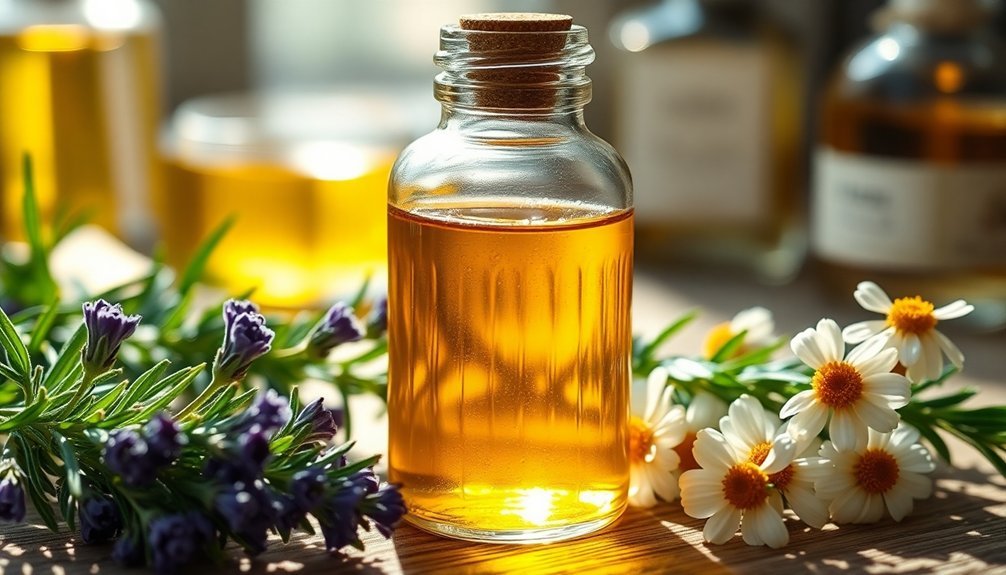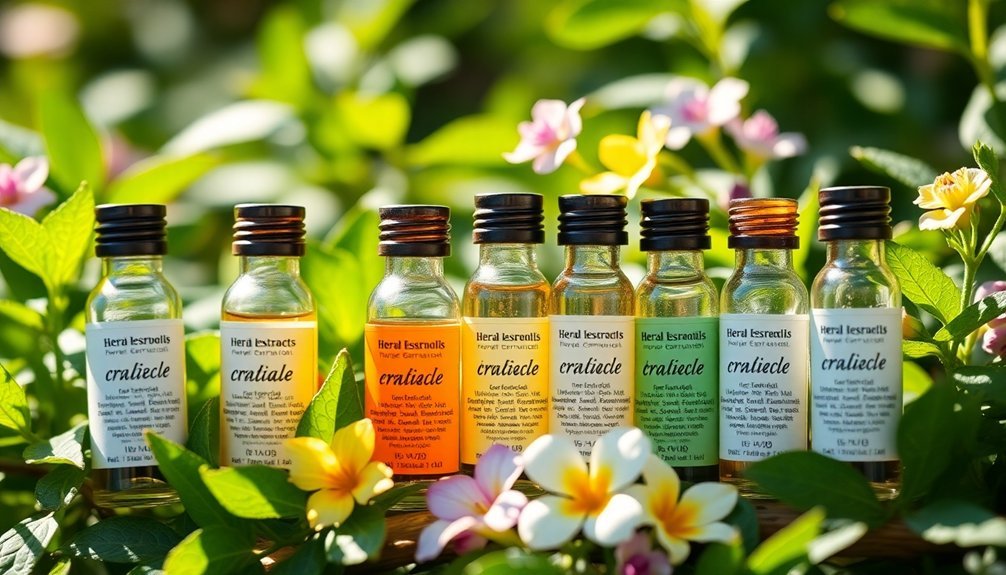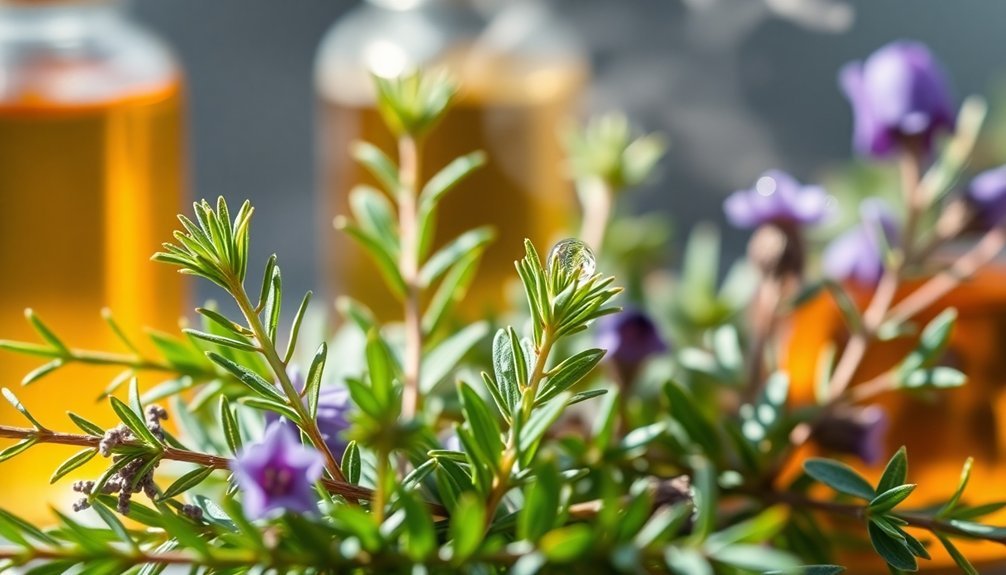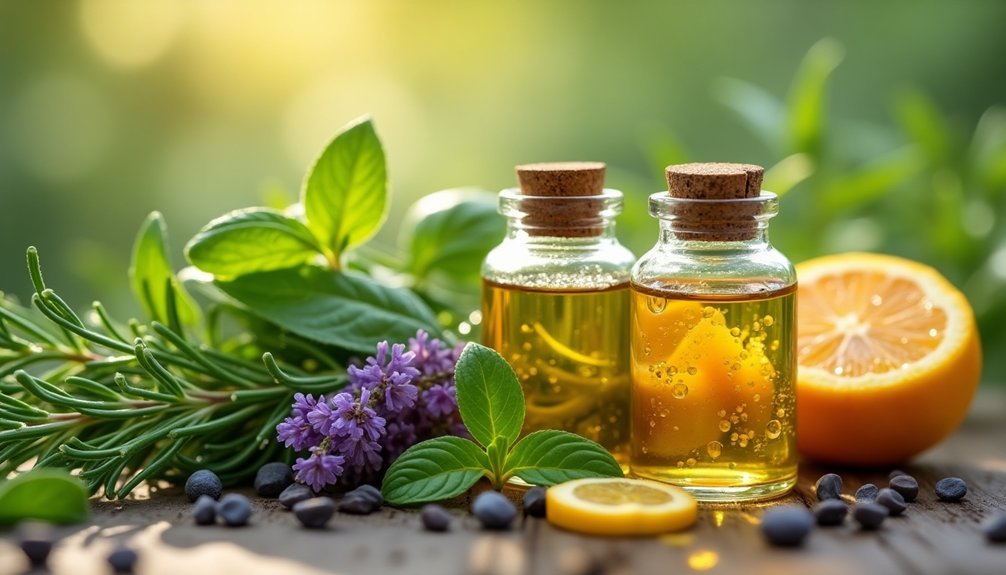Several natural extracts can notably extend your perfume's freshness and stability. Green tea extract provides powerful antioxidants, while grapefruit and asparagus extracts prevent degradation. You'll get excellent preservation from essential oils like thyme, oregano, and tea tree, which contain antimicrobial compounds. For the best results, combine these with natural fixatives like sandalwood, patchouli, or resins such as benzoin and frankincense. The world of botanical preservatives offers many more secrets to keeping your signature scent vibrant longer.
Top Herbal Extracts for Natural Perfume Preservation

When creating natural perfumes, herbal extracts serve as essential preservatives that extend your fragrance's shelf life while maintaining its integrity.
You'll find green tea extract particularly effective due to its powerful antioxidants that stabilize your perfume's components. Grapefruit extract offers similar benefits while adding a fresh note to your blend. Natural isolates produced through bacterial engineering provide additional preservation properties while remaining certified organic.
For maximum preservation, you can incorporate asparagus extract, which is rich in antioxidants that prevent degradation.
Don't overlook traditional herbal infusions and infused oils, like rose or calendula, which enhance both longevity and depth.
These extracts work best when properly processed through either solvent extraction or CO2 methods. The solvent approach yields stable, waxy materials, while CO2 extraction preserves delicate compounds without heat damage, ensuring your perfume stays fresh longer.
The Science Behind Plant-Based Perfume Stabilizers
Natural perfume preservation relies heavily on understanding the molecular behavior of plant-based stabilizers. You'll find that these compounds work through their low volatility and hydrophobic properties, which help maintain fragrance integrity over time.
When you're choosing plant-based stabilizers, consider resinoids like benzoin and frankincense, which naturally equalize vapor pressures and extend scent longevity. Understanding that diverse plant parts contribute unique fragrance profiles helps in selecting the most effective stabilizing components.
- Essential oils contain complex metabolites that contribute to stability through their biological activities.
- Plant glands synthesize these compounds, storing them in various organs from roots to flowers.
- Natural fixatives typically work best at 3-5% concentration in base notes.
The science of stabilization often involves specific extraction methods like steam distillation and microfluidization, which preserve the natural compounds while maximizing their stabilizing properties in your final perfume formulation.
Essential Oils With Natural Preservative Properties

You'll find that essential oils like thyme, oregano, clove, and tea tree offer powerful natural preservative properties through their antioxidant-rich compounds and antimicrobial actions.
These botanical extracts work as effective stabilizers in perfumes by disrupting microbial growth and protecting against oxidation, ensuring your fragrance stays fresh longer.
The oils' inherent aromatic qualities serve double duty, functioning both as preservatives and as long-lasting base notes that anchor your natural perfume compositions.
Active compounds like terpinen-4-ol in tea tree oil specifically target and disrupt bacterial cell membranes to prevent contamination.
Antioxidant-Rich Botanical Compounds
Among the most valuable ingredients in natural perfumery, antioxidant-rich botanical compounds serve as both protective agents and therapeutic additives in fragrance formulations.
You'll find powerful protection from botanical extracts like green tea, rosemary, pomegranate, and pine bark, which help prevent your perfumes from oxidizing while adding beneficial properties to your blends.
- Green tea extract contains EGCG that fights free radicals and protects other fragrance ingredients from degradation.
- Rosemary extract's carnosic acid and carnosol work as potent free radical scavengers, especially in CO2 extract form.
- Pine bark extract (Pycnogenol) regenerates vitamins C and E while providing powerful antioxidant protection.
To maximize these benefits, you'll want to store your perfumes in dark glass bottles and consider combining multiple antioxidants for synergistic effects.
Modern encapsulation technology can further enhance their stability and effectiveness.
Natural Antimicrobial Essential Oils
When formulating natural perfumes, essential oils with antimicrobial properties serve a dual purpose as both fragrant ingredients and natural preservatives.
You'll find that thyme, oregano, clove, and tea tree oils are particularly effective at protecting your fragrances. These oils contain powerful compounds like thymol, carvacrol, eugenol, and terpinen-4-ol that disrupt harmful microorganisms.
These essential oils work by targeting multiple aspects of microbial cells. They'll break down cell membranes, inhibit enzyme activity, and interfere with metabolic processes – making it difficult for bacteria and fungi to survive.
You can enhance their preservative power by combining different oils, as they often work synergistically. For maximum stability in your perfume formulations, you'll want to contemplate using encapsulation techniques to protect these essential oils from degradation.
Long-Lasting Herbal Base Notes
Creating a long-lasting natural perfume requires careful selection of herbal base notes that serve both as fragrance anchors and natural preservatives.
You'll find that oils like sandalwood, patchouli, and vetiver excel at extending your perfume's longevity while adding depth to the fragrance. These base notes work best when you apply them to well-moisturized skin, as hydrated skin retains scents longer than dry skin.
- Sandalwood acts as a powerful fixative, anchoring other fragrance notes
- Patchouli enhances the staying power of natural perfume blends
- Resins provide heavier base notes that evaporate slowly
To maximize the lasting power of your herbal perfume, store it in a cool, dark place and layer complementary scented products.
Consider using higher concentrations of these base notes in your formulations, especially when creating an Eau de Parfum.
Ancient Botanical Fixatives in Modern Perfumery
The fascinating world of ancient botanical fixatives continues to shape modern perfumery, bridging centuries-old traditions with contemporary fragrance creation.
You'll find that traditional fixatives like ambergris and civet have evolved to meet modern ethical standards through synthetic alternatives such as Ambroxan and civetone. These ingredients still deliver the same depth and longevity to your perfumes without environmental concerns.
Plant-based resins and gums remain essential players, offering rich, warm undertones while stabilizing your fragrance compositions.
When you're exploring botanical fixatives, consider orris root for its unique violet-like qualities and stabilizing properties. You can enhance your perfume's staying power by combining these time-tested botanicals with modern synthetic fixatives.
This marriage of old and new guarantees your fragrances maintain their integrity while meeting contemporary performance standards.
Antimicrobial Herbs That Extend Fragrance Life

Natural preservatives in your perfume formulations become possible through antimicrobial herbs, which serve dual purposes as both aromatic ingredients and protective agents.
You'll find powerful botanical extracts like black seed oil fighting Staphylococcus aureus, while fir balsam absolute tackles both Gram-positive and Gram-negative bacteria.
Juniper berry extract's α-pinene and D-limonene compounds actively prevent microbial degradation.
- Black seed oil contains thymoquinone, effectively inhibiting bacterial growth at 25 μg/mL
- Cubeb oil's α-copaene compounds provide significant antimicrobial protection while adding spicy notes
- Fir balsam absolute offers the strongest protection with a MIC of 12.5 μg/mL against multiple bacterial strains
These natural antimicrobials don't just preserve your perfume – they're integral parts of the fragrance composition itself.
Combining Herbal Extracts for Maximum Preservation
When creating natural perfumes, you'll want to test how different herbal extracts work together to enhance preservation power.
You can experiment with combinations like rosemary and lavender, which offer complementary antimicrobial properties while creating appealing scent layers.
The key is to carefully observe how your chosen herbs interact over time, noting which combinations maintain fragrance stability longest while preventing bacterial growth.
Blending Compatible Plant Compounds
Successfully blending herbal extracts for perfumes requires careful consideration of each compound's stability and preservation characteristics.
When you're combining different plant compounds, pair stable woody or oriental extracts with more volatile citrus or floral notes to help anchor the overall fragrance. You'll get better longevity by choosing alcohol as your primary solvent while avoiding vegetable oils that can turn rancid.
- Use dark glass bottles and tight-sealing caps to protect your blends from light and oxidation
- Store your mixtures at 2-5°C to maintain the chemical integrity of delicate compounds
- Mix larger batches into smaller 10ml portions to minimize exposure to air
Remember to monitor your blends regularly and gently agitate during maceration to guarantee proper extraction and preservation of the aromatic compounds.
Herbal Synergy Effects Testing
Testing herbal extract synergies requires a systematic approach to validate their preservation effectiveness. You'll need to combine your extracts in specific ratios and test them over a 28-day period to guarantee they provide adequate antimicrobial protection.
When testing your herbal combinations, compare them against traditional preservatives like parabens to verify their efficacy. Focus on achieving biochemical compatibility between different plant families, and guarantee your main preservative effects make up 50-60% of the formula, with secondary effects at 25-30%.
Document your results meticulously for reproducibility.
Store your test samples in amber glass bottles at temperatures between 5°C and 25°C, keeping them in a dark, dry environment. Label each sample with its composition and manufacturing date to maintain proper traceability throughout your testing process.
Natural Resins and Their Preservative Powers

Since ancient times, natural resins have served as the backbone of enduring fragrances, offering both aromatic complexity and remarkable preservative powers.
You'll find that resins like benzoin, frankincense, and myrrh don't just add depth to your perfumes – they're natural preservatives that help your scents last longer. These resins bind fragrance molecules to your skin while slowing down evaporation rates, ensuring your perfume develops beautifully throughout the day.
- Labdanum and tolu balsam create a foundation that anchors lighter top notes
- Pine resin and styrax add anti-carcinogenic properties while extending wear time
- Peru balsam and olibanum contribute deep, lasting base notes that evolve on skin
Whether you're crafting oriental fragrances or fresh herbal blends, incorporating natural resins will help stabilize your perfume while adding rich, complex undertones that unfold over time.
Choosing the Right Herbal Base for Your Blend
You'll find that roots like vetiver and resins such as frankincense serve as excellent fixatives, forming a solid foundation for your herbal perfume blends.
When you're selecting herbs for your base, consider combining grounding vetiver with stabilizing pine to create a long-lasting foundation that anchors lighter top notes.
The best fixative combinations often pair these deeper base notes with middle notes like rosemary, which helps bridge the gap between your foundation and more volatile top notes.
Roots and Resins Guide
When crafting natural perfumes, roots and resins serve as essential base notes that anchor your fragrance and extend its longevity.
You'll find that roots like vetiver and ginger provide grounding qualities, while resins such as myrrh and frankincense act as natural fixatives to help your blend last longer.
For the best results, keep roots and resins to about 20% of your total blend to avoid overwhelming other notes.
- Myrrh and frankincense resins slow down evaporation and help fragrances adhere better to your skin
- Vetiver and ginger roots add depth while balancing floral and citrus top notes
- Store your blends in cool, dark places to maintain the potency of roots and resins
Remember to test your blends regularly, as seasonal variations can affect the strength of these natural ingredients.
Best Fixative Herb Combinations
Creating a well-balanced herbal perfume depends heavily on selecting the right combination of fixative herbs for your base notes.
You'll find that pairing patchouli with sandalwood creates a deep, earthy foundation that anchors lighter scents effectively. For a fresh yet lasting blend, combine vetiver with cedarwood, which offers both stability and a natural woody undertone.
If you're seeking a sweeter profile, mix benzoin with vanilla and balsam of Peru – they'll work together to extend your perfume's longevity while adding warm, creamy notes.
For an exotic touch, blend frankincense with myrrh and labdanum, maintaining a 3-5% concentration of these fixatives in your base.
Remember to follow the 2:1:1 ratio when combining base, heart, and head notes, adjusting the proportions based on each oil's strength.
Traditional Asian Herbs in Perfume Conservation

Traditional Asian herbalism has revolutionized perfume conservation through centuries-old techniques that blend aromatherapy with preservation methods.
You'll find powerful fixatives like Agilawood and Sandalwood that not only extend your fragrance's life but also add therapeutic benefits. These herbs work through time-tested applications using censers, fumigating vases, and sachets to maximize their preservative properties.
- Huo Xiang and Mu Xiang serve as natural stabilizers while adding aromatic depth to your perfumes.
- Musk and Agilawood create a strong base that helps lock in volatile top notes.
- Sandalwood and Jasmine offer both fixative properties and therapeutic benefits, calming your senses while preserving the scent.
These traditional herbs don't just conserve your fragrances; they transform them into holistic aromatherapy experiences that last longer and work better.
Sustainable Plant Preservatives for Eco-Friendly Perfumes
Modern eco-conscious perfumery has embraced sustainable plant preservatives that protect both fragrances and the environment.
You'll find that many brands now source their preservatives from certified sustainable farms that prioritize organic ingredients and fair labor practices.
These preservatives are extracted using eco-friendly methods like steam distillation and cold pressing, which maintain the ingredients' integrity without harmful chemicals.
For example, organic rose oil and Palo Santo are harvested responsibly to protect endangered species while supporting local communities.
When you're choosing a perfume with sustainable preservatives, look for brands that use third-party certifications and practice transparency in their ingredient sourcing.
Many implement closed-loop systems and renewable energy in their production processes, ensuring your fragrance stays fresh while minimizing environmental impact.
Frequently Asked Questions
Can Herbal Extracts Affect the Color of My Perfume Over Time?
Yes, your perfume's color can change over time due to herbal extracts. They'll naturally oxidize and react with other ingredients, causing darkening or clouding. Light exposure and storage conditions affect this process too.
How Do Seasonal Changes Impact the Effectiveness of Herbal Preservatives?
Seasonal shifts can affect your herbal preservatives' effectiveness through temperature fluctuations and humidity changes. You'll need stronger preservation during hot, humid summers, while cold, dry winters require less intensive protection.
Are There Any Herbal Extracts That Should Never Be Mixed Together?
You'll want to avoid mixing citrus-based extracts with labdanum, as they can neutralize each other. Also, don't combine vanilla with musk flowers, as this pairing can create unstable compounds that degrade quickly.
Do Herbal Preservatives Work Differently on Synthetic Versus Natural Fragrances?
Yes, herbal preservatives interact differently with synthetic and natural fragrances. You'll find they're more compatible with natural scents, while synthetic fragrances already have built-in stabilizers that may not work well with herbal preservatives.
What Role Does Water Content Play in Herbal Extract Preservation Methods?
You'll find that water content substantially impacts preservation, as excess moisture can destabilize herbal extracts. It's essential to maintain ideal water levels to prevent microbial growth and guarantee your extracts' longevity and potency.
In Summary
You'll find that herbal extracts offer a natural way to extend your perfume's life without synthetic preservatives. Whether you choose vetiver root, patchouli, or myrrh for their fixative properties, or opt for antimicrobial herbs like sage and rosemary, these botanical solutions work effectively. By incorporating these plant-based preservatives into your fragrance blends, you're not only maintaining freshness but also creating more sustainable, earth-friendly scents.





Leave a Reply